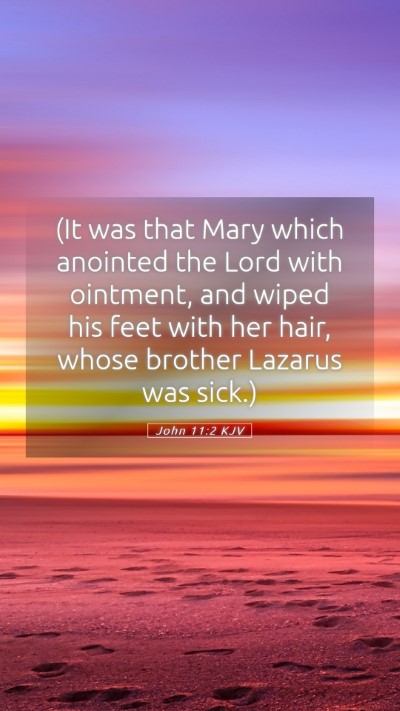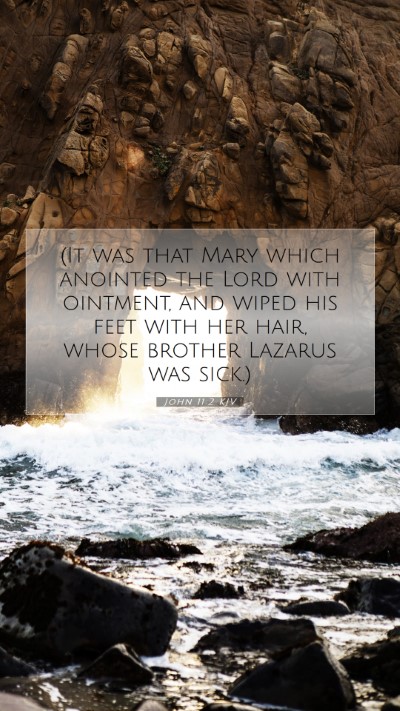Understanding John 11:2 - Bible Verse Commentary
In the Gospel of John, chapter 11, verse 2 holds significant meaning and provides a deep insight into the relationship between Jesus and those who loved Him. This verse states, "It was that Mary which anointed the Lord with ointment, and wiped his feet with her hair, whose brother Lazarus was sick." Here, we explore the Bible verse meanings, interpretations, and applications of this scripture through the lens of public domain commentaries.
Contextual Overview
John 11:2 provides an introduction to the story of Lazarus’s death and resurrection. It identifies Mary, the sister of Lazarus, who is known for her deep devotion to Jesus. Understanding the context of this verse can enhance our Bible study insights as we look at the significance of their relationship and the circumstances surrounding Lazarus's illness.
Commentary Insights
-
Matthew Henry's Commentary:
Matthew Henry emphasizes the importance of Mary’s action of anointing Jesus, which signifies her love and reverence. By mentioning her in relation to Lazarus, Henry points out that their family had a special relationship with Christ, making the tragedy of Lazarus’s illness even more poignant. This indicates that being close to Jesus does not exempt us from suffering, a vital understanding in Scripture analysis.
-
Albert Barnes' Notes:
Albert Barnes explains that this verse highlights Mary’s recognition of Jesus’s messianic role. He notes that her act of worship through pouring ointment signifies both her faith and devotion to Christ. This connection underlines the personal relationships within the narratives of the New Testament, contributing to our Biblical exegesis on how Jesus interacts with His followers.
-
Adam Clarke's Commentary:
Adam Clarke emphasizes the historical and cultural context of Mary's actions, noting that wiping Jesus’s feet with her hair was a profound expression of humility and love. Clarke points out that the mention of her name recalls an event not recorded in this Gospel but known to the early Christians, leading to a deeper understanding of Scripture and the significance of worship in the life of a believer.
Key Themes in John 11:2
-
The Relationship with Jesus:
This verse points to the close relationship between Mary, Martha, Lazarus, and Jesus, revealing an important aspect of Christian fellowship and support in times of distress. It encourages believers to develop deep relationships with Jesus in Bible study groups and personal prayer life.
-
Faith in the Face of Suffering:
Just as Mary and Martha faced dire circumstances, believers are reminded that faith in Jesus can coexist with suffering and loss, inviting reflection on how we can apply these lessons to our own lives through Bible study lessons.
-
The Call to Worship:
Mary’s act is a profound testament to the nature of worship in the Christian faith, illustrating that genuine worship serves as an acknowledgment of Jesus’s authority and compassion, relevant in Bible study topics like worship practices.
Cross References
This verse relates to several other scriptures that can enhance our understanding:
- John 12:3: Mary anoints Jesus's feet.
- Luke 10:39: Mary sits at Jesus's feet, listening to His teachings.
- John 11:43-44: The story culminates with the resurrection of Lazarus.
Conclusion
John 11:2 is a poignant reminder of the interpersonal relationships in the life of Jesus and the faith that sustains us in trials. Through the insights gleaned from Matthew Henry, Albert Barnes, and Adam Clarke, readers are offered a deeper Bible verse understanding that fosters personal growth and spiritual reflection.


